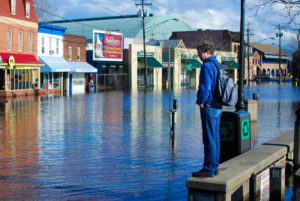
During a Time of Growing Rainfall Caused by Climate Change, Many States and Cities Planning Infrastructure Based on Outdated Data
Washington, D.C. – During a time of growing rainfall, flooding, and runoff pollution caused by climate change, a new report documents that Pennsylvania and Maryland have gone backwards in their efforts to control stormwater pollution in the Chesapeake Bay.
Pennsylvania’s 2019 Bay cleanup plan will allow almost 7 million pounds (or 87 percent) more nitrogen pollution – the Bay’s biggest killer – from urban and suburban stormwater runoff in the state into the estuary by the Bay cleanup deadline of 2025, compared to the state’s plan back in 2012, according to the report by the Environmental Integrity Project, “Stormwater Backup in the Chesapeake Region.”
Maryland’s most recent plan (called its “Phase III Watershed Implementation Plan”) will allow about 1.5 million pounds (or 20 percent) more nitrogen from stormwater runoff into the estuary from the state by the cleanup deadline, compared to the state’s 2012 plan, which used 2009 as a starting point.
Fewer investments by these two states in stormwater pollution control projects – including converting parking lots to greenspaces, planting trees, and building rain gardens – will hurt urban communities with large expanses of blacktop, which act as heat islands in the summer because of climate change, according to EIP’s report.
“It is inexcusable that Maryland and Pennsylvania are backtracking on their commitments to control urban stormwater pollution at a time when climate change and increasing rainfall are having such a huge impact on the Chesapeake Bay,” said Abel Russ, Senior Attorney for the Environmental Integrity Project and co-author of the report. “These states must step up, start planning for the precipitation and flooding we are already experiencing because of global warming, and invest in the kinds of stormwater control projects and greenspaces that will provide a range of benefits to both the Chesapeake Bay and urban and suburban communities.”
Overall, in 2019, stormwater runoff from developed land – the only major source of pollution in the Bay that is growing – contributed 16 percent of the total nitrogen pollution in the Chesapeake (40 million pounds), as well as 17 percent of the phosphorus pollution (2.6 million pounds) and 9 percent of the sediment (1.7 billion pounds), according to figures from the EPA-led Chesapeake Bay program.
“At a time of increased concerns about public health, Pennsylvania really needs to start getting serious about controlling its stormwater pollution, because our water monitoring shows it is creating a health hazard even down the street from the State Capitol Complex – which is a disgrace,” said Ted Evgeniadis, the Lower Susquehanna Riverkeeper. “Pennsylvania needs to invest more in not only Harrisburg’s water quality, but clean water for everyone downstream.”
Water quality monitoring by the Lower Susquehanna Riverkeeper in Harrisburg this summer found unsafe E. coli bacteria levels on a third of the testing days (in 20 of 60 samples taken from June 5 to July 31), with worse fecal contamination downstream of the city’s combined stormwater and sewage outfalls.
Virginia is heading in the opposite direction of Pennsylvania and Maryland and is planning and investing more to stop urban and suburban runoff. Virginia’s 2019 Bay cleanup plan would reduce nitrogen pollution from runoff into the Bay by an additional 4 percent, or 540,000 pounds, by the Bay cleanup deadline of 2025, compared to its 2012 plan.
Together, Virginia, Maryland, and Pennsylvania account for 90 percent of the stormwater pollution in the Bay.
“If Virginia can step up its efforts on stormwater pollution in the Bay, there is no reason that Pennsylvania and Maryland should be backsliding,” said Betsy Nicholas, Executive Director of Waterkeepers Chesapeake. “Because of climate change and increased rainfall and flooding, this is really an area in which all the states – and EPA – should be increasing their planning and investments, not the opposite.”
Alice Volpitta, Baltimore Harbor Waterkeeper with Blue Water Baltimore, said: “Our data shows that several measurements of water health are getting significantly worse in Baltimore’s waterways over time. The status quo isn’t working for our urban ecosystems or city residents. Over-reliance on street sweeping and trash reduction efforts, at the expense of green infrastructure projects that both treat and reduce polluted stormwater while providing tangible community benefits, is a losing strategy.”
Growing amounts of rainfall, driven by climate change, have been inundating the Chesapeake Bay region, with record-setting precipitation in 2018 in Baltimore (72 inches), Harrisburg (62 inches), Richmond (64 inches), and Washington, D.C. (67 inches), and the amount of fresh water pouring into the nation’s largest estuary in 2019 by far the highest ever recorded, averaging 130,750 cubic feet per second, according to U.S. Geological Survey.
According to one set of climate models, the northeastern United States will experience a faster increase in heavy rainfall than any other region of the country, with a four or five-fold increase in heavy precipitation events by 2100.
At the same time, suburban sprawl in the Chesapeake Bay region has been adding more blacktop and other impervious surfaces that funnel more polluted runoff into rivers, streams and the Bay. Since the current Bay cleanup plan was launched in 2009, the amount of developed land in the Bay watershed has increased by about 300,000 acres, or about 6 percent – an area six times the size of the District of Columbia.
Because of this increasing amount of development and rainfall, the stormwater planning of many municipalities is outdated, leading to more pollution and increased risks of flooding, according to EIP’s study.
EIP’s report scrutinized four cities with outdated combined sewage and stormwater systems – Cumberland, Md.; Washington, D.C.; Harrisburg, Pa.; and Lynchburg, Va. – and found that all of them are designing infrastructure improvements based on outdated and overly conservative assumptions about rainfall.
The worst case was in Cumberland, Maryland, which is planning on only 37 inches of annual rainfall as it designs an upgraded pipe system, when in reality 48 inches have been falling on that city each year over the last five years (a 27 percent difference). Washington, D.C., has a 21 percent gap between its planning and reality; Harrisburg, Pa., 15 percent; and Lynchburg, Va., 13 percent.
At the county level, EIP examined stormwater planning documents for 11 large counties in the Chesapeake Bay watershed – including Baltimore and Montgomery counties in MD; Lancaster and York counties in Pennsylvania; and Fairfax and Loudon counties in Virginia – and found all of them are planning for old rainfall averages, rather than for the larger recent and future rainfall volumes driven by climate change.
The Environmental Integrity Project’s report is based on state, city, and county records and stormwater control plans, and U.S. Environmental Protection Agency Chesapeake Bay Program pollution estimates. The report’s conclusions include the following:
- Pennsylvania’s most recent Bay cleanup plan (called its Phase III Watershed Implementation Plan) will allow about 7 million pounds more nitrogen pollution from urban and suburban runoff by the deadline of 2025 than the state promised back in 2012. The means allowing an increase in the amount of nitrogen entering the Bay from urban and suburban runoff by 250,000 pounds instead of decreasing it by 6.7 million pounds, using 2009 as the baseline.
- Pennsylvania’s newest plan, released in August 2019, would require far fewer projects to control stormwater pollution than promised by the state back in 2012. The state is now proposing to replace only 202 acres of parking lots and other “impervious surfaces” with rain-absorbing greenspaces instead of the 2,300 acres proposed earlier by the state.
- Maryland is also backtracking on the issue of stormwater pollution, allowing 1.5 million pounds more nitrogen pollution from urban and suburban runoff by the deadline than the state pledged back in 2012. The state’s 2019 Bay cleanup plan allows an increase in the amount of nitrogen pollution flowing into the Bay from stormwater by 249,000 pounds per year by 2025, compared to the 2009 baseline. Back in 2012, by contrast, Maryland had been planning for a 1.3 million-pound annual reduction by 2025.
- Compared to its 2012 plan, Maryland is now planning to build fewer stormwater-filtering projects called rain gardens (zero instead of 34,716 acres) by 2025. The state also plans to install less pavement permeable to water (zero acres instead of 350), and plant fewer forested acres along urban streams (zero instead of 26,430).
- Virginia, by comparison, is planning to do more to control urban and suburban runoff. The Commonwealth’s most recent Bay cleanup plan would reduce nitrogen pollution from urban and suburban stormwater by 408,000 pounds by 2025, and cut the amount of sediment flowing into the Bay from urban areas by 66 million pounds.
- To achieve these reductions, Virginia’s 2019 plan includes planting 30,000 trees to absorb runoff (that’s 38 times the 799 trees in its last plan), and installing 4,564 acres of pavement permeable to rain (instead of the 52 acres of permeable pavement proposed back in 2012), among other changes.
EIP’s report makes the following recommendations for solutions to the problem:
- Planning at all levels of government – from the federal government down to the county and city level – must take into account the fact that rainfall in the Bay region is increasing in both total volume and intensity. Stormwater control projects and infrastructure must be designed to current and future rainfall patterns, not historic averages from decades ago.
- EPA must take a more active leadership role and require Pennsylvania and Maryland to strengthen their stormwater control plans and account for climate change. Instead of backtracking, Pennsylvania and Maryland should expand the stormwater pollution projects in their Phase III Watershed Implementation Plans.
- EPA should require Pennsylvania to commit substantially more resources to its Bay cleanup effort, which has been far behind the other states. Federal actions could include the denial of permit approvals for major construction projects in Pennsylvania and a demand that the Commonwealth upgrade its leaky combined stormwater and sewage systems, including in Harrisburg.
- States and municipalities across the Chesapeake region should invest more in stormwater control projects, such as the construction of artificial wetlands, ponds, rain gardens and the conversion of parking lots and other impervious surfaces to green areas that absorb rain. These projects not only control runoff pollution, they also help address environmental justice issues by creating green spaces in urban areas that are often dominated by blacktop.
- Because stormwater control projects are expensive, EPA and Congress should provide substantial federal funds to state and local governments to help pay for these projects, which create jobs. Such federal investments would be a healthy economic stimulus package to help the nation rebound from the COVID-19 recession.
The Environmental Integrity Project is an 18-year-old nonprofit organization, based in Washington, D.C., that is dedicated to strengthening public policy and enforcing environmental laws to protect public health.
Waterkeepers Chesapeake is a coalition of seventeen independent Waterkeeper programs working to make the waters of the Chesapeake and Coastal Bays swimmable, fishable and drinkable.
The Lower Susquehanna Riverkeeper is fights to protect and clean up the Susquehanna River, the largest tributary to the Chesapeake Bay.
Media contacts:
Tom Pelton, Environmental Integrity Project, (443) 510-2574 or tpelton@environmentalintegrity.org
Betsy Nicholas, Waterkeepers Chesapeake, (202) 423-0504 or Betsy@waterkeeperschesapeake.org
Ted Evgeniadis, Lower Susquehanna Riverkeeper, (609) 571-5278 or lowsusriver@hotmail.com


